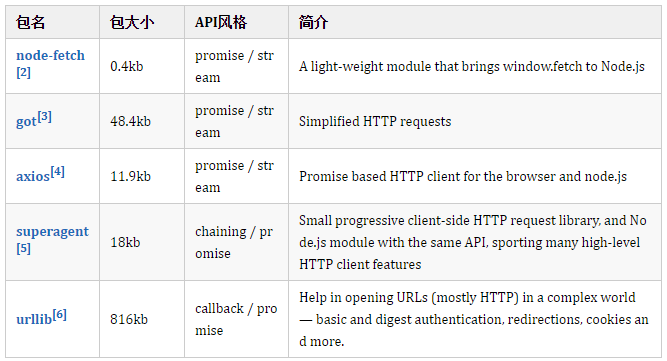
前言
在浏览器中,如果想发起一个请求,我们以前会使用到 xhr,不过这种底层 api,往往调用方式比较简陋。为了提高开发效率, jQuery 的 $.ajax 可能是最好的选择,好在后来出现了更加现代化的 fetch api 。
但是考虑到 fetch 的兼容性,而且它也不支持一些全局性的配置,以及请求中断,在实际的使用过程中,我们可能会用到 axios 请求库,来进行一些请求。到了 Node.js 中,几乎都会通过 request 这个库,来进行请求。遗憾的是,request 在两年前就停止维护了,在 Node.js 中需要找到一个能够替代的库还挺不容易的。

在 request 的 issues[1] 中,有一个表格推荐了一些在 Node.js 中常用的请求库:

浏览器中使用比较多的 axios,在 Node.js 中并不好用,特别是要进行文件上传的时候,会有很多意想不到的问题。
最近我在网的时候,发现 Node.js 官方是有一个请求库的:undici,名字取得还挺复杂的。所以,今天的文章就来介绍一下 undici。顺便提一句,undici 是意大利语 11 的意思,好像双十一也快到了,利好茅台。
- Undici means eleven in Italian. 1.1 -> 11 -> Eleven -> Undici. It is also a Stranger Things reference.
上手
我们可以直接通过 npm 来安装 undici:
- npminstallundici-S
undici 对外暴露一个对象,该对象下面提供了几个 API:
- undici.fetch:发起一个请求,和浏览器中的 fetch 方法一致;
- undici.request:发起一个请求,和 request 库有点类似,该方法支持 Promise;
- undici.stream:处理文件流,可以用来进行文件的下载;
undici.fetch
注意:该方法需要 node 版本 >= v16.5.0

在通过 undici.fetch 请求服务之前,需要先通过 koa 启动一个简单登录服务。
- constKoa=require('koa')
- constbodyParser=require('koa-bodyparser')
- constapp=newKoa()
- app.use(bodyParser())
- app.use(ctx=>{
- const{url,method,body}=ctx.request
- if(url==='/login'){
- if(method==='POST'){
- if(body.account==='shenfq'&&body.password==='123456'){
- ctx.body=JSON.stringify({
- name:'shenfq',
- mobile:'130xxxxxx'
- })
- return
- }
- }
- }
- ctx.status=404
- ctx.body=JSON.stringify({})
- })
- app.listen(3100)
上面代码很简单,只支持接受一个 POST 方法到 /login 路由。下面使用 undici.fetch 发起一个 POST 请求。
- const{fetch}=require('undici')
- constbootstrap=async()=>{
- constapi='http://localhost:3100/login'
- constrsp=awaitfetch(api,{
- method:'POST',
- headers:{
- 'content-type':'application/json'
- },
- body:JSON.stringify({
- account:'shenfq',
- password:'123456'
- })
- })
- if(rsp.status!==200){
- console.log(rsp.status,'请求失败')
- return
- }
- constjson=awaitrsp.json()
- console.log(rsp.status,json)
- }
- bootstrap()

如果将请求的方式改为 GET,就会返回 404。
- constrsp=awaitfetch(api,{
- method:'GET'
- })

undici.request
undici.request 的调用方式与 undici.fetch 类似,传参形式也差不多。
- const{request}=require('undici')
- constbootstrap=async()=>{
- constapi='http://localhost:3100/login'
- const{body,statusCode}=awaitrequest(api,{
- method:'POST',
- headers:{
- 'content-type':'application/json'
- },
- body:JSON.stringify({
- account:'shenfq',
- password:'123456'
- })
- })
- constjson=awaitbody.json()
- console.log(statusCode,json)
- }
- bootstrap()

只是返回结果有点不一样,request 方法返回的 http 响应结果在 body 属性中,而且该属性也支持同 fetch 类似的 .json()/.text() 等方法。
中断请求
安装 abort-controller 库,然后实例化 abort-controller,将中断信号传入 request 配置中。
- npmiabort-controller
- constundici=require('undici')
- constAbortController=require('abort-controller')
- //实例化abort-controller
- constabortController=newAbortController()
- undici.request('http://127.0.0.1:3100',{
- method:'GET',
- //传入中断信号量
- signal:abortController.signal,
- }).then(({statusCode,body})=>{
- body.on('data',(data)=>{
- console.log(statusCode,data.toString())
- })
- })

我们运行代码,发现是可以请求成功的,是因为我们没有主动调用中断方法。
- undici.request('http://127.0.0.1:3100',{
- method:'GET',
- signal:abortController.signal,
- }).then(({statusCode,body})=>{
- console.log('请求成功')
- body.on('data',(data)=>{
- console.log(statusCode,data.toString())
- })
- }).catch(error=>{
- //捕获由于中断触发的错误
- console.log('error',error.name)
- })
- //调用中断
- abortController.abort()

现在运行代码会发现,并没有输出 请求成功 的日志,进入了 catch 逻辑,成功的进行了请求的中断。
undici.steam
undici.steam 方法可以用来进行文件下载,或者接口代理。
文件下载
- constfs=require('fs')
- const{stream}=require('undici')
- constout=fs.createWriteStream('./宋代-哥窑-金丝铁线.jpg')
- consturl='https://img.dpm.org.cn/Uploads/Picture/dc/cegift/cegift6389.jpg'
- stream(url,{opaque:out},({opaque})=>opaque)

接口代理
- consthttp=require('http')
- constundici=require('undici')
- //将3100端口的请求,代理到80端口
- constclient=newundici.Client('http://localhost')
- http.createServer((req,res)=>{
- const{url,method}=req
- client.stream(
- {method,path:url,opaque:res},
- ({opaque})=>opaque
- )
- }).listen(3100)

总结
本文只是介绍了 undici 几个 api 的使用方式,看起来 undici 上手难道还是比较低的。但是兼容性还不太行,比如,fetch 只支持 node@v16.5.0 以上的版本。
对于这种比较新的库,个人还是建议多观望一段时间,虽然 request 已经废弃了,我们还是使用一些经过较长时间考验过的库,比如,egg 框架中使用的 urllib[7],还有一个 node-fetch[8],上手难道也比较低,与浏览器中的 fetch api 使用方式一致。
参考资料
[1]issues: https://github.com/request/request/issues/3143
[2]node-fetch: https://www.npmjs.com/package/node-fetch
[3]got: https://www.npmjs.com/package/got
[4]axios: https://www.npmjs.com/package/axios
[5]superagent: https://www.npmjs.com/package/superagent
[6]urllib: https://www.npmjs.com/package/urllib
[7]urllib: https://www.npmjs.com/package/urllib
[8]node-fetch: https://www.npmjs.com/package/node-fetch
原文地址:https://mp.weixin.qq.com/s/jgYTYE6VT9iNlAIis7fMlw

















